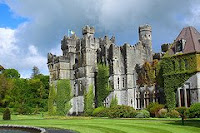
Another day of snorkling, this time to the Silk Cayes, just inside the Barrier Reef, a 45 minute boat ride from Placencia. Besides us there were 2 couples from France, who hadn't met before! Our boat driver Leo was also our guide and cook.
The Silk cayes are 3 tiny islands, and we went to the largest one: it had 12 coconut palms, 6 picnic tables, a BBQ pit and washrooms. Three large catamarans were anchored offshore, and a boat full of scuba divers came by and stopped to have their lunch, so at noon the island was positively crowded!
While Leo prepared lunch we snorkled on our own all around the island, and besides colourful fish, we saw a squid.
After lunch we had a demonstration of how to crack open a coconut, and ate some.
Then we went over to two fishing boats; they anchor and men in dugout canoes go out to fish and dive for conch, then come back to the big boat to clean the fish.
We snorkled around the boats and saw lots of nurse sharks, and two kinds of rays: spotted eagle rays and huge grey Caribbean sting rays.
Then a turtle swam by, with 2 ramoras under him. We followed, and could see the barnacles on his back - his shell was about four feet long!
People from the catamarans came over to buy fish for their dinner - can't get it much fresher than that.
In the village after dinner we watched some Garifuna drumming: one man with shakers, 2 on handmade drums, and one playing turtle shells (hanging from his neck).
It's going to be hard to leave this part of Belize; this was our last full day here.
Such beautiful cayes, white sand beaches, warm sun, and warm clear saltwater. All itchy bug bites are forgotten when you float and swim, look through your mask and are mesmerized by the whole other world below the surface.






























